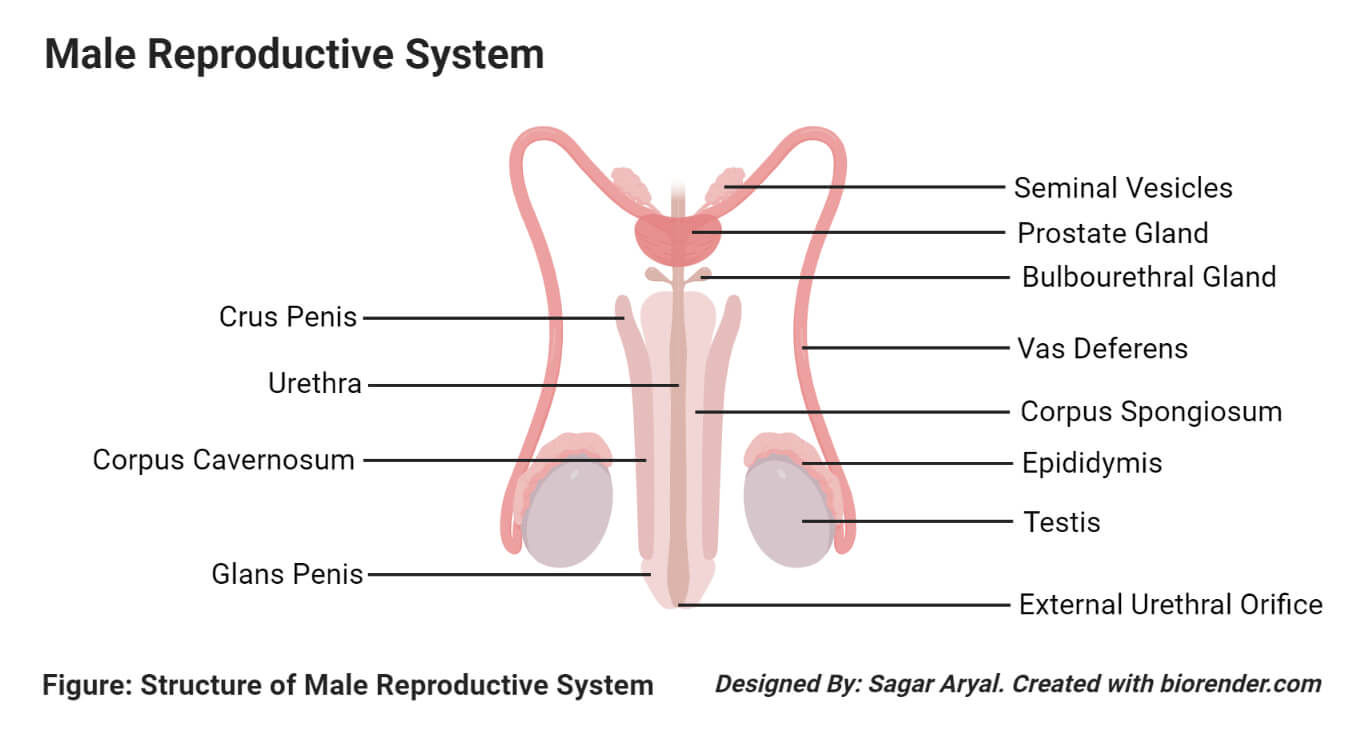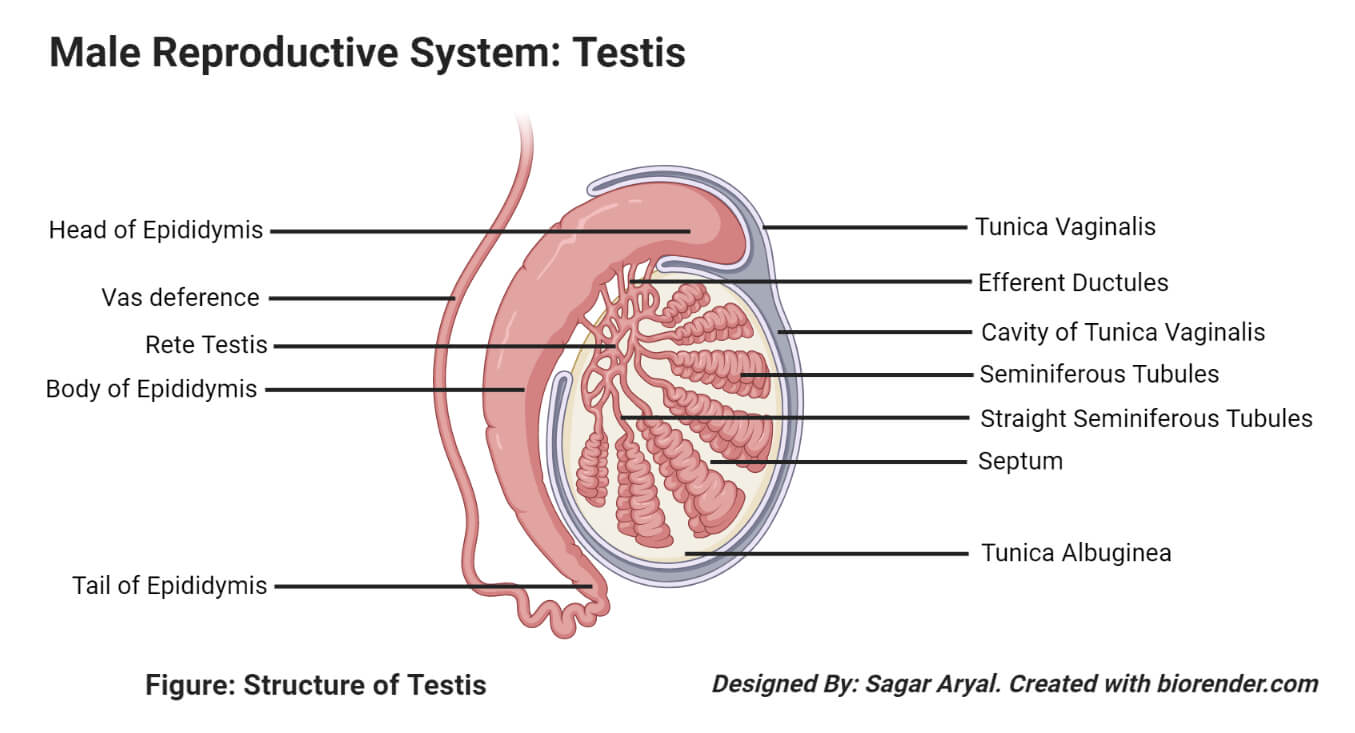Disclaimer: The information and images presented on this page are for academic, study, and educational purposes only. The terms, keywords, and images used on this page may not be suitable for some users, but they are regular terms for the human male reproductive system used only for educational purposes as a part of study information.
A male reproductive system is a group of organs and hormones that play a role in human reproduction. These organs and hormones are present either inside or outside the pelvis.
Interesting Science Videos
Organs of the Male Reproductive System
- Two testes
- Two epididymides
- Two different ducts (vas deference)
- Two spermatic cords
- Two seminal vesicles
- Two ejaculatory duct
- A prostate gland
- A penis

Structure of the Male Reproductive System
The testes, epididymides, and the testicular ends of the spermatic cords are present in the scrotum. A scrotum is a pouch-like structure that consists of fibrous connective tissues and smooth muscles. It is divided into two compartments, each of which contains one testis.
Testes
- In birds and mammals, a pair of testes are present on either side with the left one a bit larger than the right one. In the case of sharks, however, the right one is larger than the left one.
- A single testis is present in primitive jawless fish through the midline of the body which forms after the fusion of paired structures in the embryo.
- The testes are the male reproductive glands that are about 4.5 cm long, 2.5 cm wide and 3 cm thick and surrounded by three layers of tissues namely, tunica vaginalis, tunica albuginea, and tunica vasculosa.
- A testis is composed up to 900 coiled seminiferous tubules in which the sperms are formed. In the case of amphibians, however, seminiferous tubules are absent, and the sperms are present inside a structure called sperm ampullae.
- Between these tubules are interstitial cells or Leydig cells which produce the hormone testosterone after puberty.
- The seminiferous tubules are folded and tightly packed to form the epididymis which comes out of the scrotum in the form of vas deference.

Function of Testes
- The vital role of testes is the production of male gamete called sperms. Sperms are the male gametes that fertilize the female gametes during s*xual reproduction.
- Similarly, Sertoli cells in the testes are also responsible for the production of androgens, male s*x hormones, like testosterone. Testosterone is responsible for the development of secondary s*xual characteristics like the development of facial hair, deep voice, and an abrupt increase in height in males.
- Seminiferous tubules in testes are also responsible for the storage of sperms. Leydig cells in the tubules provide essential nutrients for the sperms during storage.
Spermatic Cords
The testes are suspended in the scrotum with the help of the spermatic cords. This cord is composed of a testicular artery, testicular veins, lymphatics, a deferent duct, and testicular nerves, and the vas deferens (ductus deferens). Spermatic cords are covered by a layer of connective tissues and smooth muscles.
The function of Spermatic Cords
- Vas deferens forms a part of the spermatic cord which allows the transfer of sperm from the testes to the ejaculatory duct.
- Since the cords are provided with numerous blood vessels and nerves, it provides the continuous flow of blood throughout the male reproductive system.
Seminal Vesicles
Seminal Vesicles are small fibromuscular organ surrounded by a columnar epithelium present on either side of the urinary bladder. From each of the seminal vesicles, a small duct is originated that connects to the vas deference to form the ejaculatory duct.
The function of Seminal Vesicles
- The secretory columnar epithelium present in the seminal vesicles secreted mucoid fluid rich in fructose, citric acid, and other essential nutrients.
- Once the sperms are brought to the ejaculatory duct via spermatid cords, each seminal vesicle empties its content onto the ejaculatory duct.
- The mucoid material provides nutrients and energy for the sperms until one of the sperm fertilizes the ovum.
Prostate Gland
The prostate gland is present in the pelvic cavity in front of the rectum and is surrounded by an outer fibrous layer, a layer of smooth muscle, and the glandular substance made up of columnar epithelial cells.
The function of the prostate gland
- A prostate gland secretes a thin milky fluid that is comprised of calcium ions, citrate ions, and phosphate ions along with some fibrinogen and prostaglandins, which adds to the bulk of the semen.
- The slightly alkaline nature of the fluid has a vital role in the successful fertilization of the ovum. The liquid in the ejaculatory duct is acidic owing to the citric acid and metabolic products of the sperm, which ultimately, results in inhibition of sperm fertility.
Penis
- A penis consists of a root and a body. The root part lies within the perineum, whereas the body surrounds the urethra.
- It is formed of three cylindrical masses called erectile tissue and some involuntary muscles. The erectile tissue is composed of fibrous connective tissue and is covered by skin with a large amount of blood supply.
- A penis has two lateral columns called corpora cavernosa and the column between them containing the urethra is called corpora spongiosum.
- The tip of the penis is structured into a triangular structure called glans penis above which is a movable folded skin called a prepuce.
- The blood to the penis is supplied by a deep, dorsal, and bulbar arteries and whereas the blood is drained to the iliac veins through a bundle of veins in the penis.
- It is provided with autonomic and somatic nerves.
The function of the penis
- Penile Erection is an important function of the penis caused due to the parasympathetic nerves in the penis.
- As a result of stimulation which could be psychic or physical, parasympathetic impulses reach the penis through the spinal duct.
- Under the same nervous impulses, the blood vessels in the penis become dilated, and there is a rapid flow of arterial blood through the vessels. The rapid flow of blood causes the ballooning of the fibrous tissues to the extent that causes the penis to be erect and hard.
Hormones Involved in Male Reproductive System
- Testosterone: This hormone is secreted by Leydig cells or interstitial cells present in the testes, which is involved in the development and division of germinal cells during the early stages of spermatogenesis.
- Luteinizing hormone: This hormone is secreted by the pituitary gland, which stimulates the Leydig cells to release testosterone hormone.
- Follicle Stimulating hormone: This hormone is also secreted by the anterior pituitary and functions in the stimulation of Sertoli cells which allows the conversion of spermatids into sperms.
- Estrogen: Estrogen formed from the Sertoli cells also play some role in spermatogenesis.
- Growth hormone: Growth Hormone allows the overall development of the body and protects the background activities in the testes.
References and Sources
- Hall JE and Guyton AC. (2011) Textbook of Medical Physiology. Twelfth Edition. Elsevier Saunders.
- Waugh A and Grant A. (2004) Anatomy and Physiology. Ninth Edition. Churchill Livingstone.
- 1% – https://www.slideshare.net/9426401633/reproductive-system-73578010
- 1% – https://www.ncbi.nlm.nih.gov/pmc/articles/PMC3364478/
- 1% – https://www.ncbi.nlm.nih.gov/pmc/articles/PMC3010136/
- 1% – https://www.juniordentist.com/hormones-released-from-pituitary-gland-and-their-functions.html
- 1% – https://www.healthline.com/human-body-maps/seminal-vesicles
- 1% – https://www.chegg.com/homework-help/result-stimulation-parasympathetic-nervous-system-select-app-chapter-56-problem-5bne-solution-9780323290340-exc
- 1% – https://wikimili.com/en/Testicle
- 1% – https://quizlet.com/106856323/chapter-27-review-flash-cards/
- 1% – https://infogalactic.com/info/Vas_deferens
- 1% – https://en.wikipedia.org/wiki/Human_male_reproductive_system
- 1% – https://courses.lumenlearning.com/boundless-ap/chapter/the-male-reproductive-system/
- 1% – https://courses.lumenlearning.com/ap2/chapter/the-pituitary-gland-and-hypothalamus/
- 1% – https://anatomy-medicine.com/urinary-system/150-the-penis.html
